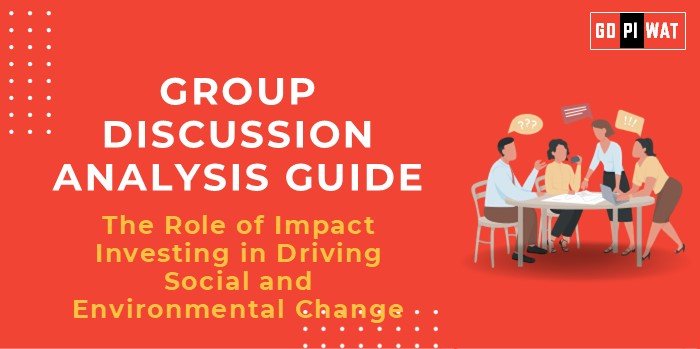📋 Group Discussion (GD) Analysis Guide
💡 The Role of Impact Investing in Driving Social and Environmental Change
🌐 Introduction to Impact Investing
Opening Context: Impact investing bridges the gap between financial returns and positive societal outcomes. With the global emphasis on sustainability, it has emerged as a crucial lever for achieving social equity and environmental conservation.
Topic Background: Originating in the early 2000s, impact investing prioritizes measurable environmental and social benefits alongside financial returns. Organizations like the Global Impact Investing Network (GIIN) have standardized metrics, while initiatives like the UN’s Sustainable Development Goals (SDGs) underline its importance.
📊 Quick Facts and Key Statistics
- Impact Investment Market: Valued at $1.16 trillion globally as of 2023 (GIIN).
- India’s Impact Funds: Mobilized over $10 billion from 2010-2022.
- Social Enterprises Growth: Annual growth of 20% in emerging markets.
- Job Creation: Impact funds have supported 1.5 million jobs globally in the renewable energy sector.
🤝 Stakeholders and Their Roles
- Government: Setting regulatory frameworks, incentivizing green bonds, and supporting social enterprises.
- Private Sector: Providing funding, technology, and expertise to scale impact initiatives.
- NGOs and Civil Society: Identifying local needs and implementing solutions.
- International Bodies: Offering global benchmarks and fostering cross-border partnerships (e.g., SDG framework).
🏆 Achievements and Challenges
✨ Achievements:
- Climate Finance Impact: $100 billion pledged under the Paris Agreement for climate adaptation and mitigation.
- Social Transformation: Affordable housing for 10 million under India’s PMAY scheme supported by impact funds.
- Education Access: Global investments in ed-tech platforms reaching 150 million underserved students.
- Women Empowerment: Microfinance initiatives have uplifted 70% of rural women in Asia.
⚠️ Challenges:
- Lack of standardized metrics for impact measurement.
- Limited awareness among institutional investors.
- Regulatory hurdles in emerging economies.
🌍 Global Comparisons:
- USA: Established Green Bond Market worth $300 billion.
- Nordic Countries: Leading ESG-compliant investments with over 80% penetration.
📖 Case Studies:
- Grameen Bank (Bangladesh): Revolutionized rural microfinance.
- Aavishkaar Capital (India): Focused on healthcare and clean energy solutions in underserved regions.
📝 Structured Arguments for Discussion
- Supporting Stance: “Impact investing drives inclusive growth by fostering sustainable businesses that generate measurable benefits for society and the environment.”
- Opposing Stance: “While impact investing is promising, its scalability and transparency remain significant concerns, limiting widespread adoption.”
- Balanced Perspective: “Impact investing has achieved notable successes, yet its potential is hindered by challenges in scaling and regulation.”
🎯 Effective Discussion Approaches
- Opening Approaches:
- “With $1.16 trillion in global investments, impact investing is redefining the boundaries between profit and purpose.”
- “The dual focus of social good and financial returns positions impact investing as the future of ethical business.”
- Counter-Argument Handling:
- Recognize scalability concerns; suggest standardized metrics like IRIS+ for transparency.
- Emphasize partnerships as solutions to regulatory barriers.
🔍 Strategic Analysis of Strengths and Weaknesses
- Strengths: Measurable outcomes, alignment with SDGs, and ethical market appeal.
- Weaknesses: High-risk investments, low awareness, and regulatory inconsistencies.
- Opportunities: Growth in ESG frameworks and global policy alignment.
- Threats: Economic instability and greenwashing risks.
📚 Connecting with B-School Applications
- Real-World Applications: ESG fund management, project evaluation in renewable energy, and CSR alignment.
- Sample Interview Questions:
- “How can impact investing enhance corporate social responsibility?”
- “What metrics would you propose for evaluating the success of impact investments?”
- Insights for Students: Focus on ESG trends, explore financial modeling for impact funds, and analyze policy impacts on investment flows.


